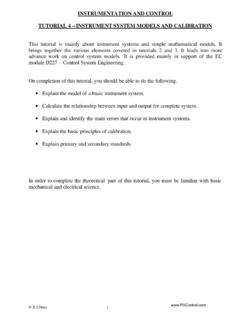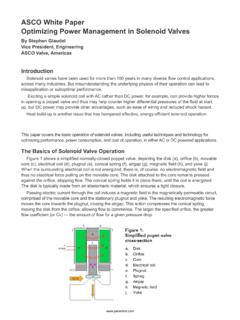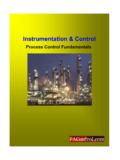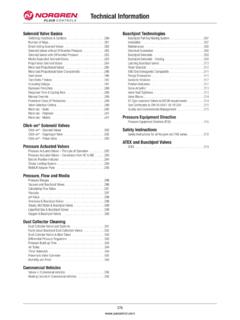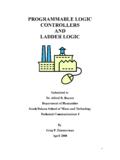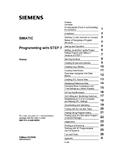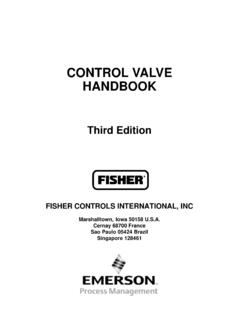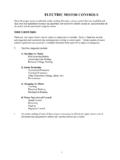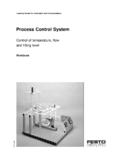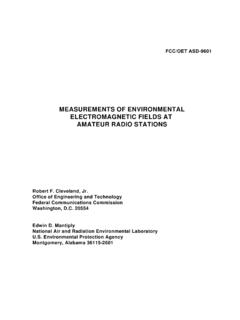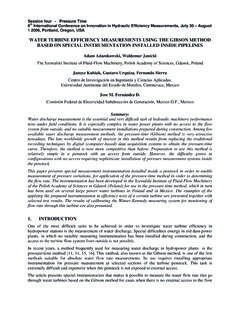Transcription of BASIC INSTRUMENTATION MEASURING DEVICES …
1 BASIC INSTRUMENTATION MEASURING DEVICES AND BASIC PID CONTROL Science and Reactor Fundamentals INSTRUMENTATION & Control i CNSC Technical Training Group Revision 1 January 2003 Table of Contents Section 1 - 3 Section 2 - INSTRUMENTATION 7 INTRODUCTION .. 7 PRESSURE MEASUREMENT .. 7 General Theory .. 7 Pressure 7 Pressure Measurement .. 8 Common Pressure 9 Differential Pressure Transmitters .. 11 Strain Gauges .. 13 Capacitance Capsule .. 14 Impact of Operating Environment .. 15 Failures and Abnormalities .. 16 FLOW 18 Flow Detectors .. 18 Square Root 25 Density Compensating Flow Detectors .. 29 Flow Measurement 31 LEVEL MEASUREMENT .. 33 Level Measurement basics .. 33 Three Valve 34 Open Tank Measurement.
2 36 Closed Tank Measurement .. 36 Bubbler Level Measurement System .. 42 Effect of Temperature on Level Measurement .. 44 Effect of Pressure on Level Measurement .. 47 Level Measurement System Errors .. 47 TEMPERATURE MEASUREMENT .. 49 Resistance Temperature Detector (RTD).. 49 Thermocouple (T/C) .. 52 Thermal 54 55 NEUTRON FLUX MEASUREMENT .. 59 Neutron Flux 59 Neutron Detection Methods .. 60 Start-up (sub-critical) 61 Fission neutron detectors .. 63 Ion chamber neutron 64 In-Core Neutron 70 Reactor Control at High 77 Overlap of Neutron 78 REVIEW QUESTIONS - EQUIPMENT .. 81 Science and Reactor Fundamentals INSTRUMENTATION & Control ii CNSC Technical Training Group Revision 1 January 2003 Section 3 - 89 INTRODUCTION .. 89 BASIC CONTROL PRINCIPLES.
3 89 Feedback Control .. 91 Feedforward Control .. 91 Summary .. 92 ON/OFF CONTROL .. 93 Summary .. 94 BASIC PROPORTIONAL CONTROL .. 95 Summary .. 97 Proportional Control .. 98 98 Practical Proportional Control .. 98 Summary .. 105 Reset of Integral Action .. 106 Summary .. 109 RATE OR DERIVATIVE ACTION .. 110 Summary .. 115 MULTIPLE CONTROL MODES .. 116 TYPICAL NEGATIVE FEEDBACK CONTROL SCHEMES 117 Level Control .. 117 Flow Control .. 118 Pressure 119 Temperature Control .. 120 REVIEW QUESTIONS - CONTROL .. 122 Note Science and Reactor Fundamentals INSTRUMENTATION & Control 3 CNSC Technical Training Group Revision 1 January 2003 OBJECTIVES This module covers the following areas pertaining to INSTRUMENTATION and control. Pressure Flow Level Temperature Neutron Flux Control At the end of training the participants will be able to: Pressure explain the BASIC working principle of pressure MEASURING DEVICES , bourdon tube, bellows, diaphragm, capsule, strain gauge, capacitance capsule; explain the BASIC operation of a differential pressure transmitter; explain the effects of operating environment (pressure, temperature, humidity) on pressure detectors; state the effect of the following failures or abnormalities: over-pressuring a differential pressure cell or bourdon tube; diaphragm failure in a differential pressure cell; blocked or leaking sensing lines; and loss of loop electrical power.
4 Flow explain how DEVICES generate a differential pressure signal: orifice, venturi, flow nozzle, elbow, pitot tube, annubar; explain how each of the following will affect the indicated flow signal from each of the above DEVICES : change in process fluid temperature; change in process fluid pressure; and erosion. identify the primary device, three-valve manifold and flow; transmitter in a flow measurement installation; state the relationship between fluid flow and output signal in a flow control loop with a square root extractor; describe the operation of density compensating flow detectors; explain why density compensation is required in some flow measurements; state the effect on the flow measurement in process with abnormalities: Vapour formation in the throat, clogging if throat by foreign material, Leaks in HI or LO pressure sensing lines; Note Science and Reactor Fundamentals INSTRUMENTATION & Control 4 CNSC Technical Training Group Revision 1 January 2003 Level explain how a level signal is derived for: an open vessel, a closed vessel with dry reference leg, a closed vessel with wet reference leg.
5 Explain how a DP cell can be damaged from over pressure if it is not isolated correctly; explain how a bubbler derives level signal for an open and closed tank; explain the need for zero suppression and zero elevation in level measurement installations; describe the effects of varying liquid temperature or pressure on level indication from a differential pressure transmitter; explain how errors are introduced into the DP cell signal by abnormalities: leaking sensing lines, dirt or debris in the sensing lines; Temperature explain the principle of operation of temperature detectors: RTD, thermocouple, bimetallic strip & pressure cylinders; state the advantages and disadvantages of RTDs and thermocouples state the effect on the indicated temperature for failures, open circuit and short circuit; Flux state the reactor power control range for different neutron sensors and explain why overlap is required: Start-up INSTRUMENTATION , Ion Chambers, In Core detectors; explain how a neutron flux signal is derived in a BF3 proportional counter; explain the reasons for start-up INSTRUMENTATION burn-out; explain how a neutron flux signal is derived in an ion chamber; state the BASIC principles of operation of a fission chamber radiation detector; state and explain methods of gamma discrimination for neutron ion chambers; explain how the external factors affect the accuracy of the ion chamber s neutron flux measurement: Low moderator level, Loss of high voltage power supply, Shutdown of the reactor; describe the construction and explain the BASIC operating principle of in-core neutron detectors.
6 Explain reactor conditions factors can affect the accuracy of the in-core detector neutron flux measurement: Fuelling or reactivity device movement nearby, Start-up of the reactor, long-term exposure to neutron flux, Moderator poison (shielding); Note Science and Reactor Fundamentals INSTRUMENTATION & Control 5 CNSC Technical Training Group Revision 1 January 2003 explain the reasons for power control using ion chambers at low power and in-core detectors at high power; Control identify the controlled and manipulated variables; sketch a simple block diagram and indicate set point, measurement, error, output and disturbances; state the difference between open and closed loop control; state the BASIC differences between feedback and feed forward control; explain the general on/off control operation; explain why a process under on/off control is not controllable at the set point; explain why on/off control is suitable for slow responding processes; explain the meaning of proportional control in terms of the relationship between the error signal and the control signal; explain why offset will occur in a control system, with proportional control only; choose the controller action for corrective control; convert values of PB in percentage to gain values and vice-versa; determine the relative magnitude of offset with respect to the proportional band setting; state the accepted system response, , decay curve, following a disturbance; explain the reason for the use of reset (integral) control and its units; sketch the open loop response curve for proportional plus reset control in response to a step disturbance.
7 State two general disadvantages of reset control with respect to overall loop stability and loop response if the control setting is incorrectly adjusted; calculate the reset action in MPR or RPM given a control system s parameters; state, the purpose of rate or derivative control; state the units of derivative control; justify the use of rate control on slow responding processes such as heat exchangers; explain why rate control is not used on fast responding processes. sketch the open loop response curve for a control system with proportional plus derivative control modes; state which combinations of the control modes will most likely be found in typical control schemes; Note Science and Reactor Fundamentals INSTRUMENTATION & Control 6 CNSC Technical Training Group Revision 1 January 2003 sketch typical control schemes for level, pressure, flow and temperature applications.
8 Note Science and Reactor Fundamentals INSTRUMENTATION & Control 7 CNSC Technical Training Group Revision 1 January 2003 INSTRUMENTATION EQUIPMENT INTRODUCTION INSTRUMENTATION is the art of MEASURING the value of some plant parameter, pressure, flow, level or temperature to name a few and supplying a signal that is proportional to the measured parameter. The output signals are standard signal and can then be processed by other equipment to provide indication, alarms or automatic control. There are a number of standard signals; however, those most common in a CANDU plant are the 4-20 mA electronic signal and the 20-100 kPa pneumatic signal. This section of the course is going to deal with the INSTRUMENTATION equipment normal used to measure and provide signals. We will look at the measurement of five parameters: pressure, flow, level, temperature, and neutron flux.
9 PRESSURE MEASUREMENT This module will examine the theory and operation of pressure detectors (bourdon tubes, diaphragms, bellows, forced balance and variable capacitance). It also covers the variables of an operating environment (pressure, temperature) and the possible modes of failure. General Theory Pressure is probably one of the most commonly measured variables in the power plant. It includes the measurement of steam pressure; feed water pressure, condenser pressure, lubricating oil pressure and many more. Pressure is actually the measurement of force acting on area of surface. We could represent this as: ForcePressureAreaFPAor The units of measurement are either in pounds per square inch (PSI) in British units or Pascals (Pa) in metric. As one PSI is approximately 7000 Pa, we often use kPa and MPa as units of pressure. Pressure Scales Before we go into how pressure is sensed and measured, we have to establish a set of ground rules.
10 Pressure varies depending on altitude above sea level, weather pressure fronts and other conditions. The measure of pressure is, therefore, relative and pressure measurements are stated as either gauge or absolute. Note Science and Reactor Fundamentals INSTRUMENTATION & Control 8 CNSC Technical Training Group Revision 1 January 2003 Gauge pressure is the unit we encounter in everyday work ( , tire ratings are in gauge pressure). A gauge pressure device will indicate zero pressure when bled down to atmospheric pressure ( , gauge pressure is referenced to atmospheric pressure). Gauge pressure is denoted by a (g) at the end of the pressure unit [ , kPa (g)]. Absolute pressure includes the effect of atmospheric pressure with the gauge pressure. It is denoted by an (a) at the end of the pressure unit [ , kPa (a)]. An absolute pressure indicator would indicate atmospheric pressure when completely vented down to atmosphere - it would not indicate scale zero.
